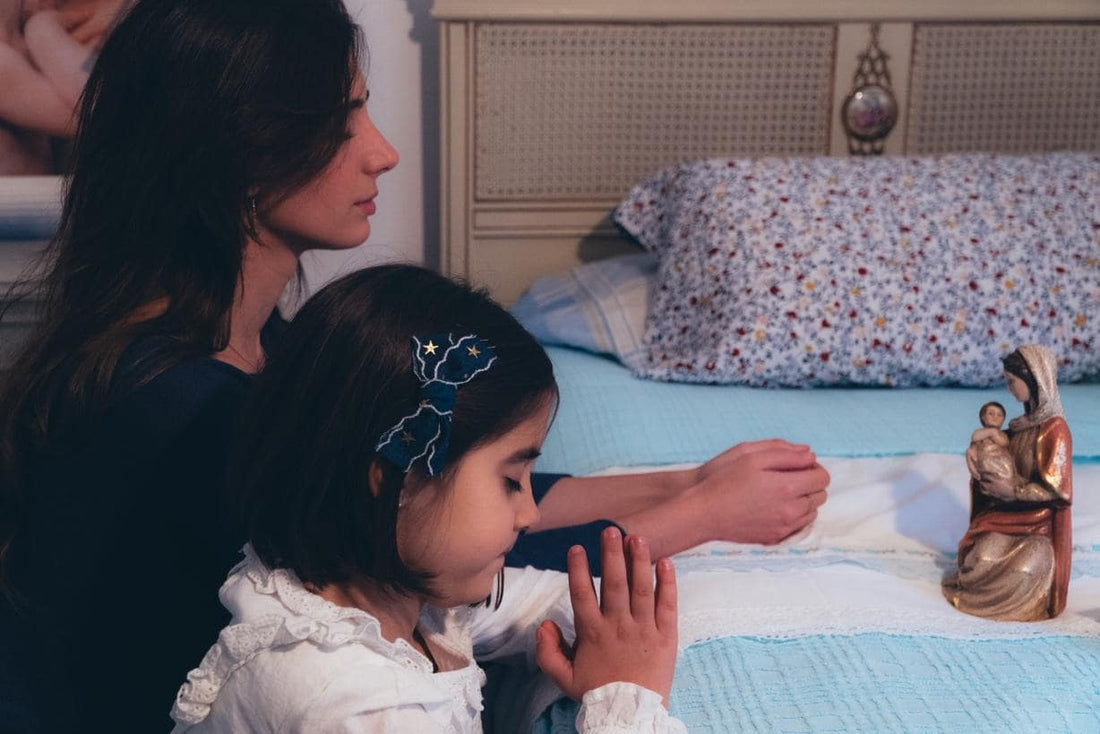
Weaving Faith Into Everyday Life: 7 Simple Ways to Keep God at the Center of Your Home
Share
It’s a beautiful gift when children are enrolled in Catholic schools and brought to Sunday Mass by their parents. These are essential foundations—but they are just the beginning. If you truly want to pass the Catholic faith on to your children, you must ask yourself:
Am I raising my children to simply identify as Catholic—or to live as practicing Catholics?
You Are the First and Best Witness of Faith
Never forget: as a parent, you are the greatest influence in your child's life. Teachers, priests, and catechists play important roles, but none compare to the daily example children receive at home. Children absorb what they see. If you want to plant the seed of faith in your child’s heart, the most powerful thing you can do is live as a practicing Catholic yourself—
- Know your faith.
- Live your faith.
- Share your faith.
Guard Against Lukewarm Faith
We all fall into routines. It’s easy to go through the motions—Mass on Sundays, occasional prayer before meals, Catholic identity in name only. But faith isn't meant to be passive.
“Have you ever felt like you're just going through the motions in your faith? You’re not turning away from God—but you’re not really drawing closer either.”
This is what Scripture warns us about in Revelation 3:16: “Because you are lukewarm—neither hot nor cold—I am about to spit you out of my mouth.”
Lukewarm faith doesn’t just impact your soul—it impacts your children’s understanding of what it means to follow Christ.
Strive for Continual Conversion
Rather than settle for surface-level faith, strive for continual conversion. This means remaining steadfast, open to growth, and constantly seeking to draw closer to God. Faith is not something that ends after First Communion or Catholic high school.
It’s a journey that deepens over time—if you let it.
Weaving Faith Into Everyday Life
In this article, we’ll share seven simple ways to make God the center of your family. These aren’t complicated or overwhelming—they're practical habits that can help your children stay rooted in Christ and see faith as an everyday reality.
When faith is alive in the home, children begin to see that Catholicism isn’t just a label—it’s a way of life to live as a person of faith.
1. Pray Together as a Family
Prayer is the heartbeat of a faith-filled home. As the saying goes, “A family that prays together, stays together.” It’s in those quiet, gathered moments that children learn to turn to God—not just in big decisions, but in everyday life.
Whether you’re praying for a sick loved one, an important test at school, a football game, safe travels, or simply peace in the middle of a stressful day, there is no intention too big or too small for God.
Make prayer a natural part of your family’s rhythm. Start with a short morning offering in the car on the way to school, say grace before meals, recite the rosary together or a decade of the Rosary before bed. Start small. What matters most is consistency and sincerity—not perfection.
Let your children hear you pray, and invite them to offer their own intentions in their own words. When they see prayer as a regular part of life, they’ll learn to lean on God for all things. Need help getting started? Use our Daily Prayer Booklets as a simple guide during family prayer time. 
2. A Perfect Family Reflection: The Stations of the Cross
The Stations of the Cross aren’t just for Lent. They’re a powerful way to help children understand the love and sacrifice of Jesus.
If you have little ones, consider reflecting over the Stations together using The Stations of the Cross Storybook in our Children’s Collection at Marie Madeleine. During Lent, make it as a family tradition—or even once a month throughout the year.

3. Faith-Filled Bedtime Routine
Bedtime is one of the most tender and teachable moments of the day. Wrap up your evening with a Bible story from our Children’s Bible – in Colour and a heartfelt bedtime prayer. Use this time to thank God together, ask for His protection, and pray for others. Let the last thought of your day be of God, as you reflect on His love, guidance, and grace.
You can also bless your children with the Sign of the Cross on their foreheads and say something simple like, “God bless you and keep you.” These small acts communicate peace, love, and security rooted in Christ.
4. Faith-Based Children’s Toys
Kids learn through play—so why not bring faith into that space, too? Browse our collection of Catholic Toys in our online shop at Marie Madeleine. Our Children’s Collection of Catholic toys help introduce your children to the saints, nurture a devotion to Jesus and Mary, keep their eyes on Jesus, and learn about the beauty of the mass.
*Catholic Toy Highlight: The Parts of the Mass Ring is more than just a teaching tool—it’s a powerful way to help children stay engaged and connected during Mass. As they follow along with each part of the liturgy, they begin to understand what’s happening and feel a sense of pride in being active participants.
This kind of hands-on involvement not only strengthens their attention but also builds confidence in their faith journey. When children are encouraged and positively reinforced for participating, they begin to see the Mass as something meaningful and personal—not just something they watch from the pews.
5. Visit Adoration
Eucharistic Adoration can seem daunting with young children, but it doesn’t have to be long to be meaningful. Even a 5–10 minute visit can plant seeds of reverence and awe in your child’s heart.
For little ones under five years old, teach them how to be reverent when they see Jesus in the exposed Eucharist by genuflecting. Then, sit in silence, teaching your child that Jesus is truly present. If your little one starts to want to move around, have them play with a church quiet toy such as a Catholic children’s picture book or our Mary Magnet Playset.
For children ages 7+ - stay for at least 20-30 minutes. Have them recite a rosary on their own. They can use our A Young Catholic’s Daily Prayer Booklet to help guide them in quiet prayer time with Jesus.

6. Put the Nativity Story First During the Christmas Season
On each Sunday of advent, together read the Nativity Story. Teach your child the true meaning of Christmas – the birth of Jesus! On Christmas Day, have a birthday cake for Jesus.
You can also set up a Nativity scene in your home and involve your children in placing the figures, saving baby Jesus for Christmas morning. Celebrate Advent as a time of waiting and preparing for Christ. These small traditions build a deeper understanding for Our Lord.
Take a look at our Children’s Sing – Along Nativity Christmas Sound Book. This interactive audio storybook combines music and storytelling to make learning about the Nativity both engaging and educational. The sound buttons invite kids to press, listen, and sing along—boosting vocabulary, strengthening listening skills, and reinforcing the message through repetition. It’s a wonderful way to help little ones connect with the true meaning of Christmas in a format they’ll love.
Go To Confession
Confession isn’t just a sacrament of obligation—it’s a gift of healing. When children see their parents going regularly, they understand that God’s mercy is something we all need. Make it a family event—monthly, if possible. Then maybe go out for ice cream or a special treat afterward to celebrate the grace received. Let them see that spiritual renewal is something joyful.
Faith Starts at Home
Faith doesn’t only grow in churches and schools—it takes root in the home, in the everyday moments where love, sacrifice, and prayer meet. By weaving simple faith practices into your family’s rhythm, you're not just teaching your children about God. You’re showing them how to walk with Him. Remember: you don’t have to do it all at once. Pick one practice to begin today—and trust that God will multiply your efforts in your children's hearts.
